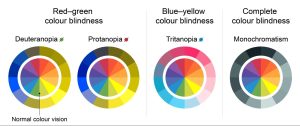Color, Depth, and Size
104 Uses of Color
Learning Objectives
Be able to discuss at least three uses of color.
Understand the possible cause of true color blindness.
Color is a visual tool that allows us to more easily navigate the outside world. We use it in various ways every day and tend not to think twice about it. Here are a few aspects of color vision to think about:
Object Detection and Recognition
Color allows us to notice and identify objects in a space. Some colors, like red and green, catch our attention more readily, and so are used more often when the desired outcome is your attention. Take a red ball. The ball’s redness makes it easy to detect (Fig.10.1.1). Or the redness of an octagonal sign ignites recognition that it is a stop sign. It would likely not illicit a reaction to stop if one day it was blue, as we have learned to identify stop signs with red.
Scene Segmentation
Color also supports our ability to separate objects in a space. Take the red ball again. We are aware that the red ball is separate from the orange block and the blue pyramid because they are not the same color (Fig.10.1.1). This difference in hue makes it easier for us to recognize the shapes as individuals and analyze them as such. Their color also allows us to separate the shapes from the green background.

Health and Mating
Color is a primary tool used across cultures and animal species to identify the health of an individual. For example, someone with greenish skin may be seen as unwell and potentially in need of medical attention. Additionally, some cultures perceive skin of a particular tones as a symbol of good health, with makeup being used in some ways to show sexual viability.
For non-human animals, the use of color not only indicates health but also acts as a tool to attract suitable mates. The peacock is one of the most common examples, the males carrying large fans of multicolored feathers.
Aesthetics
Color also helps us identify things that are pleasing to the eye. Certain color combinations succeed well in this, particularly at high saturations, evoking perceptions of beauty or perfection. Not all color combinations do this, however.

Color can help us in many other ways too, such as identifying dangerous plants and animals (a yellow and red spider is way more threatening then a light brown one); food finding (yellow bananas are normal, teal ones probably aren’t eatable); and space illusions (color on a ceiling makes a room feel smaller).
Color deficiencies can have a strong influence on how a person experiences color. Often these deficiencies are confused with “color-blindness.” However, color blindness is a complete lack of color sensation. Instead, the individual sees only in grayscale. This is a rare condition characterized by nonfunctional cones, or even a complete lack of cones altogether (the person only has rods). This can come as a result of traumatic brain injuries, such as oxygen deprivation.


Provided by: University of Minnesota
Download for free at http://vision.psych.umn.edu/users/caolman/courses/PSY3031/
License of original source: CC Attribution 4.0
Adapted by: Jarod Davis

